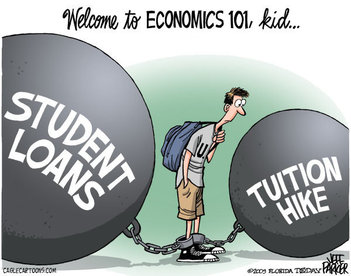
And it’s certainly a piece of legislation that needs some work.
Seven in 10 graduates left school with student loan debt in 2013, averaging more than $29,000 each, and total student loan debt surpassed $1 trillion. Despite all of that borrowing, the success rate for college attendees is still fairly low. Of all first-time, full-time students pursuing a bachelor’s degree, only 39 percent graduate in four years and 59 percent finish in six.
The guiding light for this HEA reauthorization will be a new report from the Task Force on Federal Regulations of Higher Education, a group of 16 college presidents and higher education researchers commissioned by Alexander, as well as Sens. Richard Burr (R-N.C.), Michael Bennet (D-Colo.), and Barbara Mikulski (D-Md.).
The report criticizes the current regulatory burden on colleges and claims that HEA has become a vehicle for policy objectives unrelated to education, including the mandatory celebration of Constitution Day and a requirement for strategies to combat illegal file sharing. The task force has a point, as those mandates run about 2,000 pages long and cost colleges more than 26 million hours each year. As such, the task force calls on Congress to limit these needless regulations, defray costs for student borrowers, and design ways to identify high-performing programs. But any reauthorization of HEA should also emphasize two other important priorities: lowering costs and improving programs.
Lowering costs. From 2000 to 2014, average tuition and fees at four-year public universities rose 89 percent to over $9,000 per year. One cause of this is states’ divestment in higher education. From 2008 to 2012, 29 state governments decreased their total funding to public colleges and universities. At the same time, enrollment in these institutions increased by nearly 14 percent—which forced many colleges to pass those costs on to students.
A potential solution, which was part of now-retired Sen. Tom Harkin’s (D-Iowa) HEA reauthorization plan, is the formation of state-federal college affordability partnerships, wherein the federal government would match a portion of funds that states put directly toward reducing the price of tuition. This creates a strong incentive for states to rein in the runaway cost of higher education, but it also ensures that the federal government shares the burden of doing so.
Improving programs. A reauthorized HEA could also improve the quality of teaching at colleges and universities. According to a recent Third Way report, the federal government awards more than $30 billion a year for university research, but it spends less than $80 million to incentivize quality teaching. That means, for every $100 spent on research, only 24 cents is spent on improving teaching at universities. A new HEA should reserve greater amounts of funding for investment in teacher training, blended learning, and improving the classroom experience, just like the Elementary and Secondary Education Act does for K-12 education.
It is abundantly clear that a college degree is a valuable commodity. Because of this, our higher education policies must ensure that colleges are both affordable for students and teach them the _requisite skills for future success.
Phillip Burgoyne-Allen is a legislative assistant at an education law firm. Reach him via email or Twitter.

 RSS Feed
RSS Feed